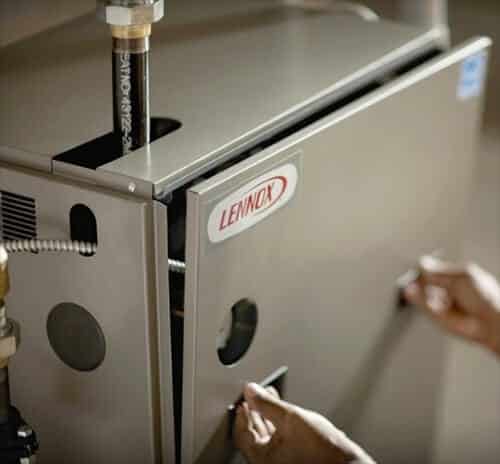7 Tips to Make Your Home’s Furnace as Energy Efficient as Possible

Each year as winter approaches, homeowners across the Seattle, WA area start to think about how much their heating bills will be for the year. As they examine current energy prices, they inevitably start to wonder if there’s anything they can do to increase the efficiency of their home’s furnace. Clearly, the best approach is to purchase a brand-new high-efficiency furnace from Brennan Heating & Air Conditioning. In lieu of that, however, there are some ways homeowners can improve the efficiency of their existing furnaces. Here are seven tips that can help achieve greater furnace efficiency.
1. Lower Your Thermostat by a Degree or Two
The simplest way homeowners can improve their furnace’s efficiency is to demand less of it. By lowering your thermostat by a few degrees, you won’t be asking your furnace to work as hard. Since it’s easier to maintain your home at a lower temperature, you won’t have to worry as much about energy loss. That translates into an instant furnace efficiency bonus.
Lowering your thermostat by a single degree may not sound like much, but it translates to significant cost savings. Over eight hours, a 1-degree decrease on your thermostat will save you approximately 1% on your annualized heating costs. That’s a pretty big benefit for a change you’re not likely to even feel!
2. Weatherproof Your Home
Another excellent way to improve your furnace’s efficiency is to cut down on how much heat it needs to generate. Weatherproofing your home is a great way to do that. You can begin by installing weatherstripping around your home’s doors and windows. That will cut down on the amount of cold air leaking into your home during the winter.
You might also want to seal any gaps you see around your doors and windows with caulk or expanding foam. For an extra efficiency boost, you can even hang insulated curtains to create a cold air barrier at each window. Together, your efforts mean a better-sealed indoor environment and less work for your furnace.
3. Change Your Furnace Air Filter
Every time your furnace turns on, it draws air through its return duct and a filter before heating it and distributing it around your home. That filter traps all of the dust and dirt carried along by your home’s air. Eventually, the filter will get so dirty that it will start to impede your furnace’s airflow. The result is worsening furnace efficiency.
It’s a good idea to change out your furnace’s filter at least once every 90 days. It’s an inexpensive maintenance item that can translate into significant furnace-efficiency gains. Plus, it’ll help keep the air in your home fresh and clean throughout the heating season.
4. Open Doors and Unblock Registers
Just like a dirty air filter, blocked or closed air registers throughout your home will create resistance that makes your furnace work harder. Making sure that all of the air registers throughout your home remain open and unblocked by things like furniture will improve your furnace’s efficiency.
Also, it’s a good idea to open up the doors to as many rooms in your home as possible. Forced-air heating systems rely on maintaining constant airflow throughout your home to operate at peak efficiency. When you close off a room, you’re trapping heated air inside and preventing it from cycling back through your furnace.
5. Adjust Airflow Dampers
The ductwork in your home’s walls is like a highway that carries heated air from your furnace to the places around your home that need it. However, the ductwork in many homes comes equipped with dampers to control airflow to the various branches of the duct network. In some cases, you might gain an efficiency benefit from adjusting those dampers to fit the season.
For example, if you have a two-story home, you could restrict the heat going upstairs while increasing the airflow to the first story. Since heat rises, this will help you to balance the temperature within your home and allow your thermostat to get an accurate reading that reflects the conditions in your home. Just make sure to reverse the changes you’ve made before the air conditioning season starts!
6. Reseal Duct Joints
When your furnace begins to send heated air through your home’s duct network, not all of it will make it to the air registers in your home. That’s because ductwork is rarely airtight, and some of the air will escape into your walls on the way to the other end. Anything you can do to prevent those losses will improve your furnace’s efficiency.
One way to do this is to examine the joints of the ductwork you can see, which is most often near the furnace itself. If you can feel warm air escaping there while the furnace runs, there’s likely a leak in one of the joints. Re-sealing those joints with duct or furnace tape can stop the leak and help more hot air reach the parts of your home that need it.
Unfortunately, since your ductwork is mostly located in the finished walls of your home, you won’t be able to address air leaks in most of the system yourself. However, a trained HVAC technician can help determine if and where your ducts may be leaking. Then they can recommend the least intrusive way to fix the problem and seal the leaks for you.
7. Insulate Exposed Ducts
The final tip we have for you in your quest to improve the efficiency of your home’s furnace is to insulate any exposed ductwork that’s part of the system. In some homes, ductwork runs exposed along a basement ceiling or through other locations, which leads to energy loss in the winter. Remember, every inch of ductwork that runs through a cold location will lower the temperature of the heated air passing through it.
To prevent that energy loss, it’s sometimes worthwhile to add insulation to your exposed ductwork. It’s not a job that you should tackle by yourself since most insulation isn’t pleasant to handle or work with. Instead, contact an HVAC specialist to tell you if additional insulation is necessary and to have them handle the work if it is.
Ask the Heating Experts
The tips detailed above will help you to improve the energy efficiency of your furnace this winter. The thing to remember, however, is that they can only do so much. If your furnace is old or in poor condition, it’s still going to cost you more than it should to operate.
So, before the temperature really starts to drop, call the experts here at Brennan Heating & Air Conditioning for help. Our highly trained HVAC technicians can evaluate your furnace and perform whatever types of maintenance or repair it needs to work efficiently. With 30 years of experience serving homeowners all over the area, there’s no better place to turn to keep your furnace in good working order. In addition to heating services, our team also offers cooling and electrical services, water heater repair, and air duct cleaning.
For furnace repair or any other questions you have about heating your home this winter, contact Brennan Heating & Air Conditioning today!







